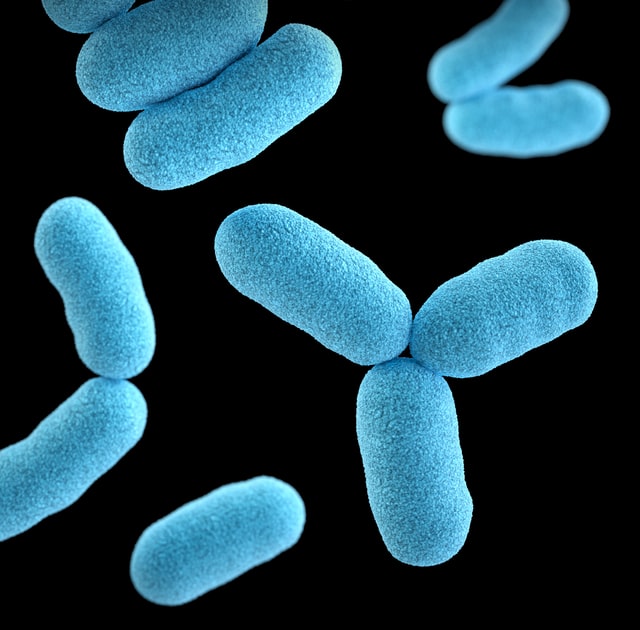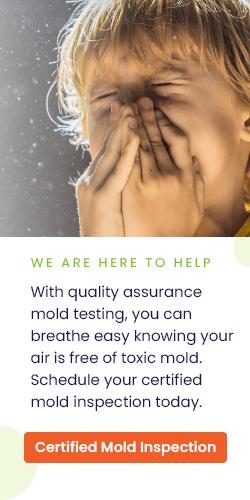Penicillium, a genus of ascomycetous fungi, has a long history of interaction with mankind; sometimes beneficial and sometimes harmful, the genus Penicillium contains over 300 species and remains poorly understood by the general public despite its widespread medical use. The genus was first identified in scientific literature by Johann Heinrich Friedrich Link in his 1809 work Observationes in ordines plantarum naturale.[1] Named after the spores’ likeness to a paintbrush (from the Latin penicillus), various species of Penicillium are found around the world, though they generally prefer cool to moderate climates.
As the name suggests, some members of the Penicillium genus produce penicillin, a molecule which has long been used as a potent antibiotic; other species are used in cheesemaking.[2] Not all types of Penicillium mold are benign, however; when certain strains of Penicillium mold multiply within the indoor environment, they can produce undesirable and even dangerous symptoms.
Penicillium: Understanding The Risks
Outside of its beneficial purposes, Penicillium is best-known as an agent of food spoilage; many species prefer to live on organic biodegradable substances and as such, they contribute heavily to the growth of visible mold on food products which are stored improperly. P. italicum and P. digitatum are notorious causes of rot of citrus fruits, for example, while P. expansum is known to spoil apples. Consuming foods which have been contaminated with Penicillium is risky owing to the fact that many species produce highly toxic mycotoxins.[3] Penicillium is of particular concern when storing food items like seeds and grains as, unlike many types of mold, it can thrive even in relatively low humidity.
Penicillium can, however, also be an airborne threat; many species have been found present in the air and dust of residences and public buildings. According to Wikipedia, “The fungus can be readily transported from the outdoors, and grow indoors using building material or accumulated soil to obtain nutrients for growth.” And, once spores are carried indoors, they easily become established thanks to their low moisture needs: “Penicillium growth can still occur indoors even if the relative humidity is low, as long as there is sufficient moisture available on a given surface.” This is particularly likely to happen in areas where rainfall is heavy, such as the coastal United States or the UK; a British study found that Penicillium spores were so prevalent in the indoor air of residential properties they sampled that spore levels indoors actually exceeded outdoor levels by 16 percent.[4] Incredibly, according to the study Growth evaluation of fungi (Penicillium and Aspergillus spp.) on ceiling tiles by John C.S. Chang, even ceiling tiles can support the growth of Penicillium if indoor humidity levels are at or above 85% and the moisture content of the tiles is greater than 2.2%.[5]
Like food-borne Penicillium species, those types of the genus which grow on indoor surfaces (and therefore disperse into indoor air) are also potential producers of mycotoxins. Additionally, even non-mycotoxic species of Penicillium can cause adverse reactions in sensitive individuals.
- verrucosum, which is found in indoor environments around the world, produces a particularly harmful mycotoxin, “ochratoxin A,” which is nephrotoxic (damaging to the kidneys) and very likely also carcinogenic (cancer causing). Though this type of mold more commonly produces toxins while growing on stored cereal grains in cold climates, it has been isolated in buildings contaminated with Penicillium.[6] Other mycotoxins commonly produced by Penicillium include:
- Patulin: Patulin is a strongly suspected carcinogen, though it has proven difficult to directly link chronic exposure to specific types of cancer. It is also toxic to mammals, as proven by rodent studies: “At relatively high doses, patulin is acutely toxic in mice and rats, causing gastrointestinal lesions, distension and haemorrhage in the stomach and small intestine… LD50 values (lethal dose) of 20-100 mg/kg bodyweight have been reported for patulin administered orally to mice and rats.” (Patulin, Richard Lawley, January 30, 2013)[7]
- Citrinin: Citrinin behaves much like a somewhat less virulent variety of ochratoxin A and has been shown to damage the kidneys of livestock, who frequently inhale it (via Penicillium spores) owing to their frequent contact with contaminated grain. According Trilogy Lab’s report on citrinin,[8] poultry were found to have damaged kidneys after being exposed to citrinin: “Poultry [were found] with the effects primarily on the kidney of these species. Regarding its relative toxicity, citrinin appears to be considerably less toxic to poultry than either oosporein or ochratoxin A, two other important nephrotoxic mycotoxins.” The report also expressed concern that citrinin could affect other major organs: “High levels of citrinin may affect the liver in addition to the kidney. In poultry common symptoms of toxicity by citrinin includes increased water consumption and diarrhea. These symptoms have been caused by levels as low as 130 and 260 ppm dietary citrinin.”
- Citreoviridin: Citreoviridin has been shown to have strongly neurotoxic effects at high doses; in lab animals, exposure has been demonstrated to cause paralysis in the extremities, followed by convulsions and respiratory arrest.[9] According to the site Toxic Black Mold, “Citreoviridin is produced by Penicillium citreonigrum, toxicarium, citreoviride,charlesii and ochrosalmoneum and Aspergillus terreus.” It has been directly implicated in “Paralysis of limbs, vomiting, convulsions, cardiovascular damage, and respiratory arrest in mice, cats, and dogs.” Citreoviridin, which frequently enters indoor environments via contaminated rice in Asia and maize in the U.S, is also suspected of causing a “Beriberi like illness in Japan and China where rice is contaminated with the mycotoxin. Chronic exposure to contaminated cereals has [also] been suggested as a cause of Keshan disease in China.”[10]
- Penitrem: Penitrem mycotoxins, which are produced by Penicillium crustosum, cyclopium and commune, often enter indoor air through contaminated stored foods (meats, nuts, cheeses, eggs, fruits, and cereals. Penitrem is also neurotoxic, with cases of both canine and human poisoning having been reported. Though Penitrum is most toxic when consumed orally via food, it likely also has detrimental effects when inhaled.
- Verrucosidin: Another neurotoxin, verrucosidin has long been associated with a neurological disease in cattle in the USA and may pose a human health hazard as well. (J. Amer. Vet Med. Assoc. 179: 480-81,1991).
Penicillium also produces a range of mycotoxic acids, such as penicillic acid and cyclopiazonic acid; both of these have acute toxic effects in mammals—they have been shown to be the “casual agents of liver and kidney lesions in mice fed with contaminated corn.”[11]
Additionally, according to mold authority Mold Help.org, Penicillium “Is further known to produce tropolones puberulic acid and puberulonic acid, a mycotoxin of unknown structure, and a -(L)-malic acid that acts as a proteinase inhibitor. As with all toxigenic fungi, exposure to penicillium does alter human DNA and can cause permanent neurological, pathological, immunological and psychological damage.” While “Penicillium marneffei produces many serious infections that can be focal or disseminated that can affect the bone marrow, kidneys, lungs, intestines, liver, spleen, skin, and soft tissue.” These infections, which may result from either oral consumption or inhalation, typically result in symptoms such as fever, weight loss, anemia, skin lesions, cough, hepatomegaly, adenopathies, and pulmonary infiltrates.
Some species of Penicillium do not typically produce serious toxins, but remain an item of concern for immunocompromised individuals. P. Marneffei, for example, has been linked to serious opportunistic infections in patients with AIDS—so much so that its isolation from blood is considered an HIV marker in areas where P. Marneffei is present. This type of Penicillium is the third most common opportunistic pathogen among HIV-positive individuals in Southeast Asia, where it is often transmitted to human populations via infected bamboo rats.[12]
Identifying Penicilium In Indoor Environments
While it is relatively easy to identify Penicillium which has grown extensively on stored food items thanks to the mold’s often vivid blue-green or yellow color, properly identifying the various types of this mold which may infiltrate indoor air is far more challenging. Indeed, many species of Penicillium can only be properly identified by having a professional sample taken by a qualified indoor air expert.
If you have access to a microscope, you can get a general idea of whether or not you are dealing with a type of Penicillium mold by looking for their characteristic dense broom-like spore-bearing structures, known as phialides. These phialides are usually flask shaped and there will be chains of spores (conidia) extending from their tips. The spores are typically green in color, and though they lack a uniform shape, they are frequently fairly round with smooth to roughened walls. (For a more detailed description of how to identify Penicillium using a microscope, visit this link.) This process of identification will, however, only be able to tell you that you are dealing with a species of Penicillium, not which species exactly or what type of mycotoxins it is producing. For such detailed information, you will still need to have a sample sent away to a lab.
Penicillium (most commonly P. Chrysogenum, which seems particularly well-adapted to infiltrating the air of residences and buildings), can usually be located either:
- Growing in cellulose materials within homes and buildings (e.g. plants, wood, paper, etc.). Penicillium can often be found growing in carpet, old mattresses and upholstered furniture, wallpaper, and even within fiberglass duct insulation where there is sufficient humidity. Damp building materials and items like books, boxes, and wood stored in moist basements are a particular hazard.
- In abandoned or damaged structures: When a building becomes damaged in such a way that moisture can seep through wallpaper, wallpaper glue, decaying fabrics, chipboards, and behind paint, Penicillium infestation becomes incredibly likely. If your home has a leaking roof or a cracked foundation it is highly recommended that you have a professional inspect it for mold before proceeding with repairs.
- In decaying organic matter: Plant debris and spoiled food provide an ideal environment for Penicillium, so compost heaps, improperly kept houseplants, and spoiled food should always be removed from the indoor environment as soon as possible.
Though P. Chrysogenum is not usually the most virulently toxic strain of Penicillium, it does produce a number of toxins of moderate toxicity and it is highly allergenic.[13] Due to its allergenic nature and status as a respiratory irritant, it can contribute to the development of serious conditions like chronic rhinitis, sinus infections, and pneumonia. It is therefore extremely important to seek professional assistance as soon as you either suspect a Penicillium infestation or notice an environment in your home where it is very likely to occur (e.g. a chronically damp basement full of stored furniture). Likewise, if you are experiencing symptoms such as frequent congestion, coughing, itching, and sneezing and your doctor has not been able to isolate an identifiable cause for these symptoms, it is a good idea to have your home inspected for hidden mold infestations.
[1] Link, JHF (1809). “Observationes in ordines plantarum naturales. Dissertatio I”. Magazin der Gesellschaft Naturforschenden Freunde Berlin (in Latin) 3: 3–42.
[2] Penicillium, Wikipedia, https://en.wikipedia.org/wiki/Penicillium
[3] Penicillium, Wikipedia, https://en.wikipedia.org/wiki/Penicillium
[4] Guidelines on ambient intramural airborne fungal spores, https://www.ncbi.nlm.nih.gov/pubmed/21243933
[5] Growth evaluation of fungi (Penicillium and Aspergillus spp.) on ceiling tiles, John C.S. Chang, http://www.sciencedirect.com/science/article/pii/1352231095000624
[6] Penicillium, http://www.moldbacteria.com/mold/penicillium.html
[7] Food Safety Watch, http://www.foodsafetywatch.org/factsheets/patulin/
[8] http://www.trilogylab.com/uploads/Citrinin.pdf
[9] Handbook of Food Toxicology, S.S. Deshpande, https://books.google.ca/books?id=Ex5QNLO-UkMC&pg=PA421&lpg=PA421&dq=Citreoviridin+neurotoxin&source=bl&ots=QdVu58i-s-&sig=08_SzF0RfkdpekKg3oAw2x2BSZo&hl=en&sa=X&ved=0ahUKEwj1zcfhiovMAhUhtYMKHUGMAKIQ6AEIGzAA#v=onepage&q=Citreoviridin%20neurotoxin&f=false
[10] http://www.blackmould.me.uk/aflatrem.html
[11] http://www.mold-help.org/content/view/424/
[12] Penicillium, http://www.moldbacteria.com/mold/penicillium.html






